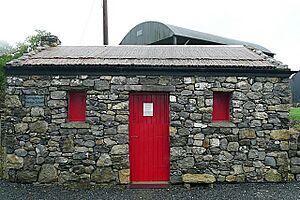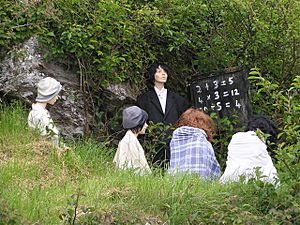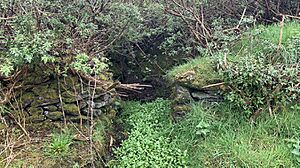Hedge school facts for kids



Hedge schools were small, secret schools in Ireland, especially during the 1700s. They taught basic subjects to children whose families were not part of the official Anglican church, such as Catholics and Presbyterians. Before 1792, only schools run by Anglicans were allowed. So, Catholics and Presbyterians had to set up these secret schools, often meeting in private homes.
Contents
History
Why Hedge Schools Started
After the 16th and 17th centuries, many Irish leaders lost their power. This meant that the old schools, which had taught Irish poetry and culture for hundreds of years, had to change. Teachers and students from these old schools began teaching in secret Catholic schools. These schools also sometimes helped train priests for the Catholic Church, which was not allowed at the time.
Where and What They Taught
Even though they were called "hedge schools," classes usually happened indoors. They met in houses or barns, especially after the strict laws against them became a bit softer. Teachers were usually paid for each subject they taught. Very bright students sometimes even traveled to Europe to get more education at special colleges for Irish students.
The main subjects taught were reading, writing, and math. Students learned both the Irish language and the English language. Some schools also taught Irish bardic poetry, local history, and home economics. In a region called Munster, some students even learned ancient Greek and Latin! One politician in England was surprised that young people in County Kerry were carrying books by famous Roman writers like Cicero and Virgil.
Reading was often taught using small, exciting storybooks called "chapbooks." These books were sold at village fairs and often told tales of famous "rapparees." Rapparees were like outlaws, but many of them were from important Irish families who still followed old traditions.
Laws and Education
From 1723 to 1782, all Catholic education was officially against the law in Ireland. The laws were meant to make Irish Catholics convert to the Protestant Church of Ireland if they wanted a good education. However, historians don't know of any hedge teachers who were actually put in jail. The laws mostly targeted Catholic schools run by religious groups, whose property was often taken away.
Historians agree that hedge schools provided education for many children. By the mid-1820s, up to 400,000 students were attending these schools. People really wanted their children to get an education, and parents made big sacrifices to send their kids to hedge schools. The teachers were often seen as part of their own community.
The Decline of Hedge Schools
After 1800, formal schools for Catholics, run by trained teachers, started to appear. For example, Edmund Ignatius Rice founded two groups of religious brothers, the Congregation of Christian Brothers and the Presentation Brothers. They opened many schools that were legal and organized. These new schools were known for being very strict.
Hedge schools began to disappear after the British government started the national school system in the 1830s. Most Catholic bishops preferred this new system. This was because the new schools would be largely controlled by the Catholic Church and would allow Catholic teachings to be taught in a formal way. Bishop James Warren Doyle wrote in 1831 that the new system would help "suppress hedge schools" and ensure students were taught by "competent teachers."
However, some hedge schools continued to exist into the 1890s. This was often because of rural poverty and a lack of resources in some areas, not just because of religious oppression.
Learning in Hedge Schools
After 1900, some historians, like Daniel Corkery, focused on the idea that hedge schools mainly taught classical subjects like Latin and Greek. While these subjects were taught in some schools if there was a demand, they were not taught in every hedge school.
One inspector visiting a school in 1835 was amazed by a twelve-year-old boy's reading skills. The inspector asked the boy to read from the Gospel of Saint Matthew. The boy misunderstood and instead read a passage about Christ's passion in Greek from his worn-out book. This shows how advanced some of the students could be.
See also

